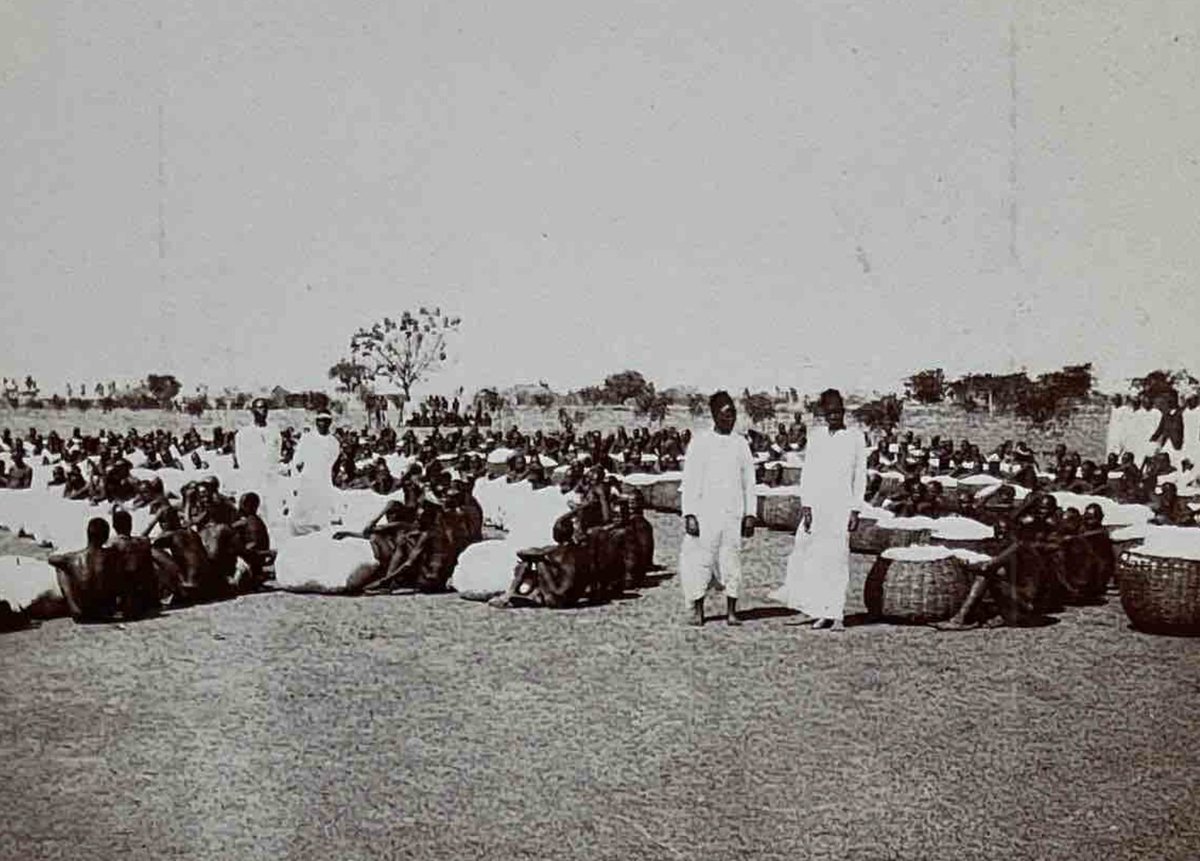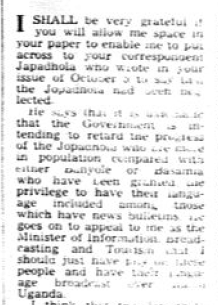
Historian @CentreC | Chair @UgandaStudies | International Research Fellow @TourBugandaUG | Author @BasicBooks @HachetteBooks | Represented by @BrentMHoward
How to get URL link on X (Twitter) App


 Following Muteesa's deportation, women exhibited distress throughout Buganda as they lamented the metaphorical loss of a husband. As early as January 1954, Rebecca Mulira initiated various campaigns throughout Buganda to guarantee the end of the Kabaka's exile. 2/9
Following Muteesa's deportation, women exhibited distress throughout Buganda as they lamented the metaphorical loss of a husband. As early as January 1954, Rebecca Mulira initiated various campaigns throughout Buganda to guarantee the end of the Kabaka's exile. 2/9

 At various points throughout the 1960s, Benedicto Kiwanuka revealed a vivid sense of his own vulnerability. The death threats and anti-DP violence that marked the 1961 and 1962 elections left their wounds,
At various points throughout the 1960s, Benedicto Kiwanuka revealed a vivid sense of his own vulnerability. The death threats and anti-DP violence that marked the 1961 and 1962 elections left their wounds, 


 L to R: Omukama Rukidi III of Tooro, Omukama Winyi IV of Bunyoro, Governor of Uganda (F. Crawfoerd), Colonial Secretary (I. Macleod), Kabaka Muteesa II of Buganda, Omugabe Gasiyonga II of Ankole, and Kyabazinga H. Muloki of Busoga. 2/4
L to R: Omukama Rukidi III of Tooro, Omukama Winyi IV of Bunyoro, Governor of Uganda (F. Crawfoerd), Colonial Secretary (I. Macleod), Kabaka Muteesa II of Buganda, Omugabe Gasiyonga II of Ankole, and Kyabazinga H. Muloki of Busoga. 2/4


 which outlined the Kingdom's postcolonial constitution. 2/9
which outlined the Kingdom's postcolonial constitution. 2/9 

 The region maintained a high standard of living throughout the colonial period. By 1953, Teso District was the largest cigarette-consuming area in eastern Africa, a reflection of its wealth, among other things. 2/4
The region maintained a high standard of living throughout the colonial period. By 1953, Teso District was the largest cigarette-consuming area in eastern Africa, a reflection of its wealth, among other things. 2/4

 But as many scholars have since shown, there were deep interconnections b/w kingdoms & republican societies. These involved trade, healing networks, mining knowledge, diplomatic channels, and much more. This very rare photograph shows a diplomatic watch tower 2/4
But as many scholars have since shown, there were deep interconnections b/w kingdoms & republican societies. These involved trade, healing networks, mining knowledge, diplomatic channels, and much more. This very rare photograph shows a diplomatic watch tower 2/4



 were taken on the day of the fire. They show how the roof and infrastructure were utterly destroyed within 1 hour. The current Cathedral was rebuilt during the First World War. 2/5
were taken on the day of the fire. They show how the roof and infrastructure were utterly destroyed within 1 hour. The current Cathedral was rebuilt during the First World War. 2/5 

https://twitter.com/JonathonLEarle/status/1513713465550118916Abakulu n'abakulu tibaleekaana: singa Nnamasole ayitirizza Mulerere; ekigerere we kifuluma kiwakanya kinnaakyo.

 Throughout the 1940s & 1950s, Ugandan writers & diplomats thought deeply about Cold War propaganda. Okot p’Bitek used Wer pa Lawino to complicate Catholic claims that the UPC was merely a communist puppet party. In her lament, Lawino asserted,
Throughout the 1940s & 1950s, Ugandan writers & diplomats thought deeply about Cold War propaganda. Okot p’Bitek used Wer pa Lawino to complicate Catholic claims that the UPC was merely a communist puppet party. In her lament, Lawino asserted,

 Throughout the early 1960s, activists in KY and DP were engaged in a pamphleteer war. For their part, KY argued that Kiwanuka sought to eat the kingship. As one pamphlet read: 2/15
Throughout the early 1960s, activists in KY and DP were engaged in a pamphleteer war. For their part, KY argued that Kiwanuka sought to eat the kingship. As one pamphlet read: 2/15 

 Lydia Boyd, Ashley L. Greene, @moseskhisa, Genevieve Meyers, @florencebrisset @rileysline, Margaret Nagawa, Fiona Siegenthaler, Holly Hanson, Asiimwe B. Godfrey, @AdrianJBrowne @Kalinaki @rwakabukoza, & Danson S. Kahyana. The cover is beautifully designed by Canon Rumanzi. 2/7
Lydia Boyd, Ashley L. Greene, @moseskhisa, Genevieve Meyers, @florencebrisset @rileysline, Margaret Nagawa, Fiona Siegenthaler, Holly Hanson, Asiimwe B. Godfrey, @AdrianJBrowne @Kalinaki @rwakabukoza, & Danson S. Kahyana. The cover is beautifully designed by Canon Rumanzi. 2/7

 Mackay accentuated Kabaka Mwanga's request for missionaries, which was likely designed to echo Kabaka Muteesa I's earlier letters in the Daily Telegraph. 2/4
Mackay accentuated Kabaka Mwanga's request for missionaries, which was likely designed to echo Kabaka Muteesa I's earlier letters in the Daily Telegraph. 2/4 


 12 Oct. '62: 'Today, of course, everyone knows that [...] near the site of Mutesa's palace, is a beautiful, well-ordered city and the seat of the Government of Uganda. However, the railway does not go everywhere, 2/10
12 Oct. '62: 'Today, of course, everyone knows that [...] near the site of Mutesa's palace, is a beautiful, well-ordered city and the seat of the Government of Uganda. However, the railway does not go everywhere, 2/10

 penetrating questions—some similar, others not—re: labour, class & racial exploitation, gender, family debates, resistance, & historical imagination. As @ElleniZeleke reminds us, Gerima's later films, Imperfect Journey & Teza, question revolutionary violence surrounding 1974. 2/
penetrating questions—some similar, others not—re: labour, class & racial exploitation, gender, family debates, resistance, & historical imagination. As @ElleniZeleke reminds us, Gerima's later films, Imperfect Journey & Teza, question revolutionary violence surrounding 1974. 2/ 

 wherever he or she may be to be quiet as you did when the boundary commission was doing its work." At length, he continued, "I ask all people of Bukedi to be calm about our land problem. [...] All of our trust is within God who created us on this jolly land of Bukedi. 2/9
wherever he or she may be to be quiet as you did when the boundary commission was doing its work." At length, he continued, "I ask all people of Bukedi to be calm about our land problem. [...] All of our trust is within God who created us on this jolly land of Bukedi. 2/9 

 insisted on accruing revenues from the region's cement production. On 20 February 1956, for instance, writers in Dobozi suggested that 'the Buganda Government should share in the revenue derived from Tororo cement [...] 2/7
insisted on accruing revenues from the region's cement production. On 20 February 1956, for instance, writers in Dobozi suggested that 'the Buganda Government should share in the revenue derived from Tororo cement [...] 2/7 
